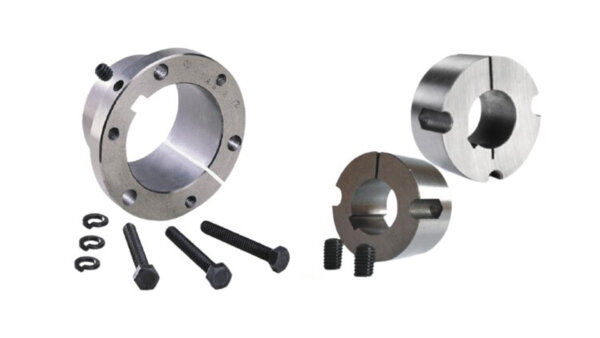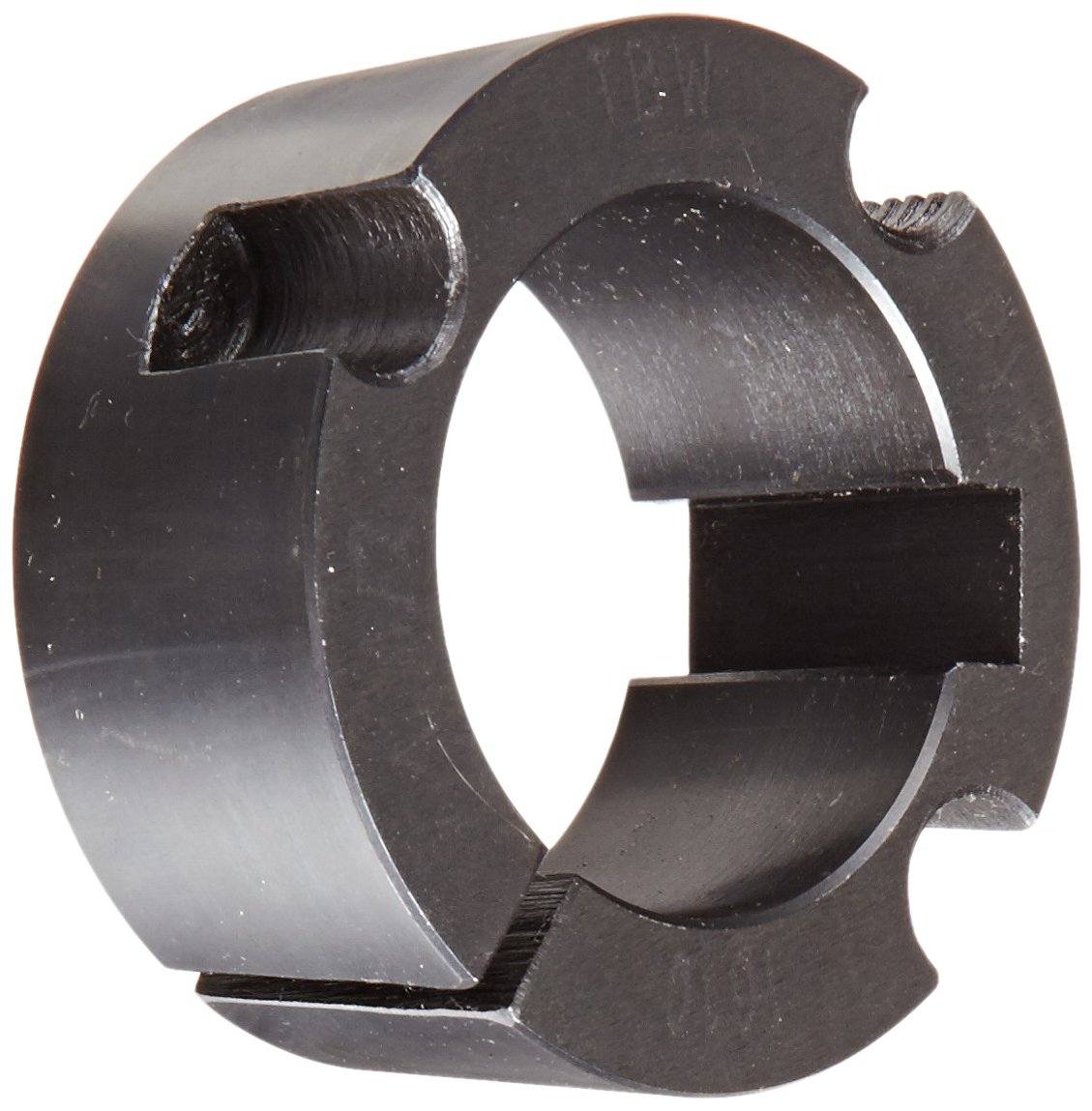Product Description
Taper lock bushing,
1. Taper bushes form the most convenient and cost effective method of fixing components to a
Mating shaft, without the need for any machining process.
2. Size ranges from 1,more information,please contact us.
3. Easy to install and remove.
4. Shallow keyway is available.
To Install:
1.Clean shaft,bore,and outside of bushing,and bore of hub(taking bushing from hub if already assembled).Remove any oil.lacquer,or dirt.
Placing bushing in hub and match half holes to make complete holes(each complete hole will be threaded on 1 side only).
2.Oil thread and point of set screws or thread and under head of cap screws.
Place screws loosely in holes thatare threaded in hub 1 side see install bore.
3.Make sure bushing is free in hub.Slip assembly CHINAMFG shaft and locatd in position desired.
4.Tighten screws alternately and evenly until all are pulled up very tightly.Use a piece of pipe on wrench to increase leverage,
please refer to taper bushing screw torque which need to be asked.
5.If stall key,place it in the shaft keyway before install taper bushing.
6.After drive has been running under load for a short time stop and check tightness of screws.Fill other holes with grease to exclude dirt.
/* March 10, 2571 17:59:20 */!function(){function s(e,r){var a,o={};try{e&&e.split(",").forEach(function(e,t){e&&(a=e.match(/(.*?):(.*)$/))&&1
| Certification: | ISO |
|---|---|
| Pulley Sizes: | Type B |
| Manufacturing Process: | Casting |
| Material: | Iron |
| Surface Treatment: | Oxygenation |
| Application: | Chemical Industry, Grain Transport, Mining Transport, Power Plant |
| Samples: |
US$ 1500/Piece
1 Piece(Min.Order) | |
|---|
| Customization: |
Available
| Customized Request |
|---|

Are there any online calculators for determining the required taper bush size?
Yes, there are online calculators available that can help in determining the required taper bush size for specific applications. These calculators utilize various input parameters such as shaft diameter, hub diameter, torque, speed, and other relevant factors to provide recommendations on the appropriate taper bush size. Here are some sources where you can find online calculators for determining the required taper bush size:
- Manufacturer Websites: Many taper bush manufacturers provide online calculators on their websites to assist customers in selecting the correct taper bush size. These calculators are often based on the manufacturer's specific product range and include fields for inputting the necessary parameters. By entering the required information, such as shaft and hub dimensions, torque, and speed, the calculator can generate recommendations on the suitable taper bush size.
- Engineering and Mechanical Websites: Several engineering and mechanical websites offer online calculators and tools that cover a wide range of mechanical components, including taper bushes. These calculators are typically designed to provide general recommendations and may not be specific to a particular manufacturer's product range. They often require input parameters such as shaft diameter, hub diameter, and other relevant dimensions to calculate the appropriate taper bush size.
- Mobile Applications: Some mobile applications cater to mechanical engineering and power transmission calculations. These apps may include features for determining the required taper bush size based on input parameters such as shaft diameter, hub diameter, torque, and speed. They can be convenient for on-the-go calculations and are often available for both Android and iOS devices.
When using online calculators for determining the required taper bush size, it is important to ensure that the input parameters are accurate and representative of the specific application requirements. The calculated results should serve as a starting point for selecting the appropriate taper bush size, and it is advisable to cross-reference the recommendations with manufacturer catalogs or consult with technical experts to verify the suitability of the chosen size.
Additionally, keep in mind that while online calculators can be helpful tools, they may not account for all the nuances and specific factors of your application. It is still recommended to consult with taper bush manufacturers, suppliers, or engineering professionals to validate the calculated size and ensure a proper fit for your specific application.
By utilizing online calculators as a guide, you can simplify the process of determining the required taper bush size and make informed decisions when selecting the appropriate component for your application.

What are the common materials used in manufacturing taper bushes?
In the manufacturing of taper bushes, several materials are commonly used, each offering different properties and characteristics to meet specific application requirements. Here are some of the common materials used in the manufacturing of taper bushes:
- Steel: Steel is one of the most widely used materials for manufacturing taper bushes. It offers excellent strength, durability, and resistance to wear and corrosion. Different grades of steel, such as carbon steel or alloy steel, may be utilized based on the specific application demands. Steel taper bushes are suitable for a wide range of industrial applications and can handle high loads and harsh operating conditions.
- Stainless Steel: Stainless steel taper bushes are chosen for applications that require enhanced corrosion resistance. Stainless steel contains a higher percentage of chromium, which forms a protective oxide layer on the surface, providing resistance against rust and corrosion. Stainless steel taper bushes are commonly used in environments where exposure to moisture, chemicals, or high humidity is expected.
- Cast Iron: Cast iron is another popular material for manufacturing taper bushes. It is known for its excellent strength, wear resistance, and vibration damping properties. Cast iron taper bushes are suitable for applications where shock absorption and reduced noise levels are desired. They are commonly used in machinery, automotive, and construction industries.
- Aluminum: Aluminum taper bushes offer advantages such as lightweight, good thermal conductivity, and resistance to corrosion. They are typically used in applications where weight reduction is crucial or where non-magnetic properties are required. Aluminum taper bushes are commonly employed in industries such as aerospace, marine, and electronics.
- Brass: Brass is a material that combines excellent machinability with good corrosion resistance. Brass taper bushes are commonly used in applications where aesthetics and appearance are important, such as architectural or decorative installations. They are also suitable for applications involving electrical conductivity, such as in electrical equipment or grounding systems.
- Plastics: Certain engineering plastics, such as nylon or acetal, are used in the manufacturing of taper bushes. These plastics offer advantages like low friction, self-lubrication, and resistance to chemicals and moisture. Plastic taper bushes are often employed in applications where noise reduction, lightweight construction, or non-magnetic properties are required. They are commonly found in industries such as food processing, packaging, or medical equipment.
The choice of material for taper bushes depends on various factors, including the application environment, load requirements, desired performance characteristics, and cost considerations. It's important to select a material that provides the necessary strength, durability, and compatibility with other components in the power transmission system.
When seeking taper bushes, it's advisable to consult with manufacturers, suppliers, or industry experts who can provide guidance on the most suitable material based on your specific application needs and operational requirements.

Where can I get information on the key dimensions of taper bushes for compatibility?
If you are looking for information on the key dimensions of taper bushes for compatibility, there are several sources where you can obtain this information. Here are some common places to find the key dimensions of taper bushes:
- Manufacturer's Catalogs and Websites: Taper bush manufacturers often provide detailed catalogs or product listings on their websites. These catalogs typically include comprehensive information about the dimensions, sizes, and specifications of their taper bushes. You can find details such as bore diameter, taper angle, outside diameter, keyway dimensions (if applicable), and overall length. Manufacturer catalogs are valuable resources for understanding the compatibility of taper bushes with different shaft sizes and mating components.
- Engineering Handbooks and Reference Guides: Engineering handbooks and reference guides related to mechanical power transmission or bushing selection may contain information on the key dimensions of taper bushes. These resources are commonly available in libraries, technical bookstores, or online platforms. They provide in-depth knowledge about various types of bushings, including taper bushes, and offer guidance on selecting the appropriate size and dimensions based on shaft requirements.
- Supplier or Distributor Documentation: If you are working with a specific supplier or distributor for taper bushes, they may provide documentation that includes dimensional information. This documentation can be in the form of product datasheets, brochures, or technical specifications. Check with your supplier or distributor to see if they have any resources available that outline the key dimensions of the taper bushes they offer.
- Online Engineering Resources: Online platforms dedicated to mechanical engineering, industrial equipment, or power transmission systems can be excellent sources of information on taper bush dimensions. Websites, forums, or communities focused on mechanical engineering topics often have discussions, articles, or downloadable resources that include dimensional data for taper bushes. Conducting targeted searches using relevant keywords can help you find these online resources.
- Consulting with Industry Experts: If you require specific or detailed information regarding the key dimensions of taper bushes for compatibility, consulting with industry experts or professionals in the field can be beneficial. These experts have practical experience and knowledge about power transmission systems and can provide guidance on selecting the appropriate taper bush dimensions based on your specific application requirements.
When accessing information on the key dimensions of taper bushes, it's important to refer to reliable and trusted sources. Ensure that the information is up-to-date and aligns with industry standards. Double-check any measurements or specifications to ensure accuracy before making final decisions on taper bush compatibility.
By utilizing these various sources, you can gather the necessary information on the key dimensions of taper bushes to determine their compatibility with different shaft sizes and mating components in your power transmission system.


editor by CX 2024-02-23